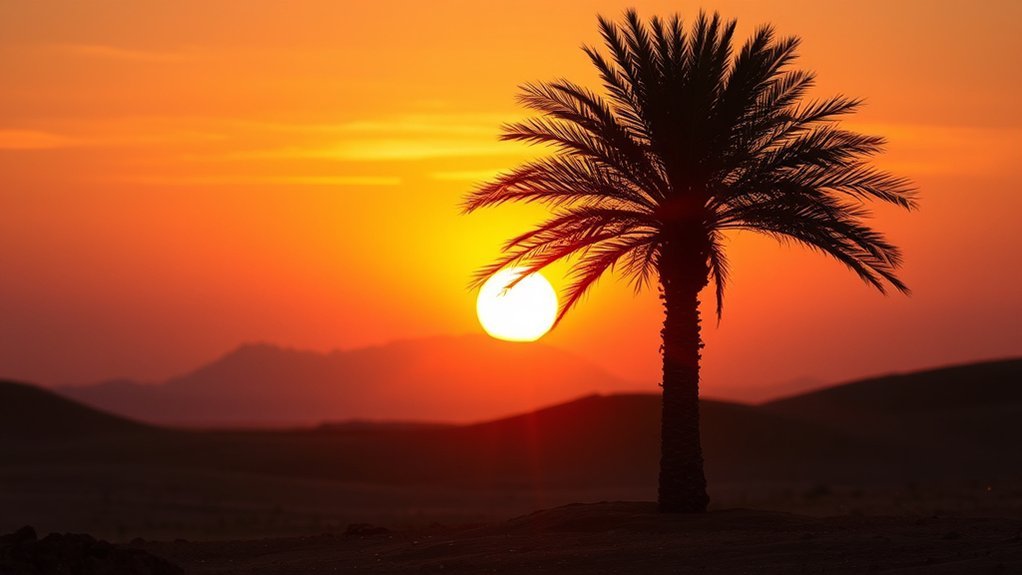Palm trees stand tall and graceful against sunny skies. They are not just pretty; they show strength and endurance. Different cultures often tell stories about palm trees. These stories celebrate victories and the bond between people. But there’s even more to these trees than their lovely look. What hidden meanings do these famous symbols hold?
Key Takeaways
Palm trees are special. They stand for success, peace, and victory. Many old cultures, like those in Mesopotamia and Egypt, used them as symbols of good things happening.
Palm trees are tough. They can grow in hard places and bend with the wind but never break. This shows how strong and adaptable they are.
In different religions, palm branches are sacred. They represent peace and common beliefs. People use them in important ceremonies.
Palm trees also give us hope and show us that new beginnings are possible. They remind us to face challenges and celebrate our victories.
Today, many people love palm trees for their beauty. They help us appreciate nature, connecting communities and making us feel good about the environment.
Historical Significance of Palm Trees in Ancient Civilizations
Palm trees are more than just pretty sights on tropical vacations. They’ve a long history in ancient civilizations. In places like Mesopotamia and Egypt, palm trees stood for peace and victory. People used their leaves to decorate royal symbols, showing power and connection to the gods.
In busy markets, palm trees provided shade for merchants and travelers. They played an important role in trade, where people bought and sold goods. The dates from palm trees fed many families and helped different cultures work together.
Palm trees helped people feel at home. They reminded communities of their land and history. Understanding their importance shows us how palm trees are part of our shared story.
Cultural Symbolism of Palm Trees Across the World
Palm trees hold different meanings in cultures around the world. They bring people together during festivals and celebrations. These tall trees are often seen in art that shows happiness and strength.
- In the Caribbean, palm trees stand for freedom and joy. They’re used in colorful festival decorations.
- In the Mediterranean, they symbolize peace and prosperity, often linked to good harvests.
- In Asia, palm trees connect the earthly world with the spiritual world, playing a role in many stories.
- In the Middle East, they represent hospitality and are commonly found in places where people gather.
These meanings help us see how palm trees connect people and cultures, showing our shared experiences.
Palm Trees in Religious and Spiritual Contexts
Many cultures celebrate palm trees in their festivals and respect them in religious and spiritual ways. Palm branches are special symbols. They stand for peace and victory. You can see them in many rituals that honor old traditions.
In Christianity, palm branches represent Jesus’ joyful entry into Jerusalem. This moment brings hope and a sense of community for believers.
In ancient times, people saw palms as sacred to gods. They stood for life and fertility, bringing people together through shared beliefs.
Palm trees connect us to these important ideas. They remind us of our own journey for connection and spiritual growth.
When you think about palm trees, consider how they carry a rich spiritual history.
The Palm Tree as a Metaphor for Resilience and Hope
Palm trees show us what resilience means. They stand tall and strong even in bad weather. These beautiful trees can bend without breaking. They remind us that hope can grow even when times are tough. When you see a palm tree, think of it as a story of challenges and victories.
- They survive storms and dry spells.
- They grow in places that seem too harsh.
- They stand firm despite troubles around them.
- They represent new beginnings and ongoing life.
As you move through life, let palm trees inspire you.
They’re symbols of hope, reminding you that, no matter how hard things get, you have the strength to bounce back and thrive.
Modern Interpretations of Palm Trees and Their Symbolism
Palm trees have changed a lot in how we see them today. They’re now symbols of green design and tropical beauty. We often picture them as part of nature in our busy cities. They make us feel like we belong to a peaceful paradise where we can relax and care for the Earth.
You can find palm trees in backyards and cafes. They show a lifestyle that appreciates both beauty and taking care of our environment. Palm trees remind us of sunny beaches and fun days. They help us feel connected to happy memories.
When we enjoy palm trees, we support a movement that values nature. They help bring people together and create a sense of community.
Frequently Asked Questions
How Do Palm Trees Survive in Harsh Desert Climates?
Palm trees do well in hot desert places thanks to some cool tricks. They grow long roots that reach deep into the ground to find water. Their leaves are special too; they help the tree keep moisture in. This helps the palm tree survive even when the sun shines really bright. Nature has given these trees the tools they need to thrive in tough conditions.
What Are the Different Species of Palm Trees?
There are many types of palm trees, each one special in its own way. Some palm trees, like the Sago and Majesty, look very nice and can make gardens and yards feel calm and peaceful. Their leaves sway gently in the breeze, inviting everyone to enjoy their beauty.
Let’s explore a few common palm tree types. The Sago palm isn’t a true palm but looks similar. It has a thick trunk and beautiful green leaves that make it stand out. The Majesty palm is tall and elegant, adding a touch of grace to any space.
Palm trees can come in different shapes and sizes. Some are small and perfect for indoor spaces, while others grow tall enough to touch the sky. No matter where they are planted, they always bring a little bit of sunshine and a tropical feel.
Are Palm Trees Native to Specific Regions?
Yes, palm trees come from specific places. They grow mainly in warm tropical and subtropical areas. These trees are strong and beautiful, showing how nature can adapt to different environments. Many people love palm trees because they remind us of sunny beaches and relaxing vacations.
How Can I Grow a Palm Tree at Home?
Growing a palm tree at home is fun and rewarding! Here’s how you can do it easily.
First, pick a good type of palm tree. Some popular choices for indoors are the Areca palm and the Parlor palm. They are small and look nice in any room.
Next, make sure your palm gets enough light. Place it near a window where it can enjoy bright, indirect sunlight. If your home is a bit dark, you can use a grow light to help it out.
Water your palm tree when the soil starts to feel dry. It likes moisture, but don’t drown it! Make sure the pot has holes to let extra water escape. This helps keep the roots healthy.
Also, use soil that drains well. A mix made for palm trees or houseplants works well. Good soil helps your palm grow strong.
Finally, keep an eye on your palm tree. Look for any yellow leaves or spots. These signs tell you if it needs something, like more water or light.
With the right care, your palm tree will grow tall and beautiful, adding a refreshing touch to your home. Enjoy watching it flourish!
What Pests Commonly Affect Palm Trees?
Palm trees can have some pesky visitors. Watch for spider mites, scale insects, and weevils.
To keep your palm trees healthy, check them often. Make sure they have the right amount of water. If you notice pests, you can use insecticidal soap or neem oil to help protect your trees.
Taking care of your palms is important, and keeping an eye out for these pests will help them thrive!

Hello, I’m Zephyra, your guide at SpiritualityEssence.com. I’m passionate about uncovering life’s mysteries and sharing transformative insights. Let’s explore mindfulness, ancient rituals, and the path to a more awakened life together. Join me on this spiritual journey!

















